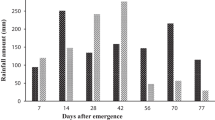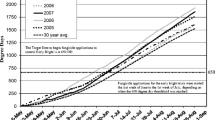Abstract
The goal of this research was to evaluate the management techniques of cultivar selection, fungicide application number, fungicide spray timing, and nitrogen rate management. Cultivars of Superior, Shepody, and Russet Burbank were observed to differ in disease severity and yield. White mold was observed to be a yield limiting factor for Superior with r2 values of 0.65 and 0.66 for the relationship between white mold severity and total and marketable yield, respectively. In contrast, Russet Burbank and Shepody had only 2 % to 4 % of yield variation explained by white mold severity. Superior showed significant yield responses to two boscalid applications as opposed to one or zero, and was the only cultivar to show a response to fungicide application number. Analysis of fungicide application timing showed discrepancies between responses of severity (quadratic effect) and yields (linear effect). Lowest severity was modeled to be at applications made at peak flowering, while highest yields were modeled to be at applications made prior to. Nitrogen rates were observed to affect white mold incidence whereby disease counts were elevated at nitrogen application rates below 134 kg/ha as compared to application rates in excess of 134 kg/ha.
Resumen
La meta de esta investigación fue evaluar las técnicas de manejo de selección de variedades, número de aplicación de fungicidas, tiempos en la aspersión de fungicidas y el manejo del nivel de nitrógeno. Se observaron las variedades Superior, Shepody y Russet Burbank para diferenciarlas en severidad de enfermedad y rendimiento. Se observó que el moho blanco era un factor limitante en el rendimiento para Superior con valores de r2 de 0.65 y 0.66 para la relación entre la severidad de moho blanco y rendimiento total y comercial, respectivamente. En contraste, Russet Burbank y Shepody tuvieron solamente de 2 % a 4 % de variación en el rendimiento adjudicable a la severidad del moho blanco. Superior mostró respuestas de rendimiento significativas a dos aplicaciones de boscalid, en oposición a una o cero, y fue la única variedad en mostrar una respuesta al número de aplicaciones del fungicida. El análisis sobre el tiempo de aplicación del fungicida mostró discrepancias entre respuestas a severidad (efecto cuadrático) y rendimientos (efecto lineal). Se observó que la severidad más baja estuvo con aplicaciones hechas en plena floración, mientras que los rendimientos más altos se observaron con aplicaciones previas. Se observó que los niveles de nitrógeno afectaron la incidencia del moho blanco, en donde las lecturas de enfermedad fueron elevadas a niveles de aplicación de nitrógeno abajo de 134 kg/ha, en comparación con los niveles de aplicación excediendo los 134 kg/ha.



Similar content being viewed by others
References
Andrivon, D., J.-M. Lucas, C. Guerin, and B. Jouan. 1998. Colonization of roots, stolons, tubers and stems of various potato (Solanum tuberosum) cultivars by the black-dot fungus Colletotrichum coccodes. Plant Pathology 47: 440–445.
Atallah, Z.K., and D.A. Johnson. 2004. Development of Sclerotinia stem rot in potato fields in south-central Washington. Plant Disease 88: 419–423.
Atallah, Z.K., and D.A. Johnson. 2006. Timing fungicide applications for managing Sclerotinia stem rot of potato. Plant Disease 90: 755–758.
Bolton, M.D., B.P.H.J. Thomma, and B.D. Nelson. 2006. Sclerotinia sclerotiorum (Lib.) de Bary: Biology and molecular traits of a cosmopolitan pathogen. Molecular Plant Pathology 7: 1–16.
Brown, M.B., and A.B. Forsythe. 1974. Robust tests for the equality of variances. Journal of the American Statistical Association 69: 364–367.
Collins, A., D. Milbourne, L. Ramsay, R. Meyer, C. Chatot-Balandras, P. Oberhagemann, W. De Jong, C. Gebhardt, E. Bonnel, and R. Waugh. 1999. QTL for field resistance to late blight in potato are strongly correlated with maturity and vigor. Molecular Breeding 5: 387–398.
Cuomo, G.J., D.G. Johnson, and W.A. Head Jr. 2001. Interseeding kura clover and birdsfoot trefoil into existing cool-season grass pastures. Agronomy Journal 93: 458–462.
Hegedus, D.D., and S.R. Rimmer. 2005. Sclerotinia sclerotiorum: When “to be or not to be” a pathogen? FEMS Microbiology Letters 251: 177–184.
Johanson, A., and H.D. Thurston. 1990. The effect of cultivar maturity on the resistance of potatoes to early blight caused by Alternaria solani. American Potato Journal 67: 615–623.
Kirk, W.W., K.J. Felcher, D.S. Douches, J. Coombs, J.M. Stein, K.M. Baker, and R. Hammerschmidt. 2001. Effect of host plant resistance and reduced rates and frequencies of fungicide application to control potato late blight. Plant Disease 85: 1113–1118.
Kora, C., M.R. McDonald, and G.J. Boland. 2003. Sclerotinia rot of carrot: An example of phenological adaptation and bicyclic development by Sclerotinia sclerotiorum. Plant Disease 87: 456–470.
Kora, C., M.R. McDonald, and G.J. Boland. 2005. Lateral clipping of canopy influences the microclimate and development of apothecia of Sclerotinia sclerotiorum in carrots. Plant Disease 89: 549–557.
Krupinsky, J.M., K.L. Bailey, M.P. McMullen, B.D. Gossen, and T.K. Turkington. 2002. Managing plant disease risk in diversified cropping systems. Agronomy Journal 94: 198–209.
Plant, A.B., and D.H. Lambert. 2005. Control of white mold on Irish Potato using fungicides at full bloom, 2004. Fungicide and Nematicide Tests, 60: V083. Online publication. doi:10.1094/FN60.
Plant, A.B., and D.H. Lambert. 2013. Host traits influencing severity of white mold of potatoes in a rainfed environment. American Journal of Potato Research. doi:10.1007/s12230-013-9327-y.
Sands, P.J., C. Hackett, and H.A. Nix. 1979. A model of the development and bulking of potatoes (Solanum tuberosum L.). Field Crops Research 2: 309–331.
Sexton, P., A. Plant, S.B. Johnson, and J. Jemison. 2007. Effect of a mustard green manure on potato yield and disease incidence in a rainfed environment. Crop Management. doi:10.1094/CM-2007-0122-02-RS.
Visker, M.H.P.W., H.M.G. van Raaij, L.C.P. Keizer, P.C. Struik, and L.T. Colon. 2004. Correlation between late blight resistance and foliage maturity type in potato. Euphytica 137: 311–323.
Wharton, P., and W. Kirk. 2007. Michigan potato diseases: White mold. Michigan State University, Online. Extension Bulletin E-2989.
Acknowledgments
We appreciate the help and support of Erica and Albert Fitzpatrick, Bruce and Brandon Roope, Steve Gray, Gregory Alley-Violette, Elbridge Giggie, and James Dwyer. This work was supported by a grant from the Maine Potato Board Research Committee.
Author information
Authors and Affiliations
Corresponding author
Rights and permissions
About this article
Cite this article
Plant, A.B., Lambert, D.H. & Porter, G.A. Managing White Mold of Potatoes in a Rainfed Environment. Am. J. Potato Res. 90, 378–385 (2013). https://doi.org/10.1007/s12230-013-9315-2
Published:
Issue Date:
DOI: https://doi.org/10.1007/s12230-013-9315-2




